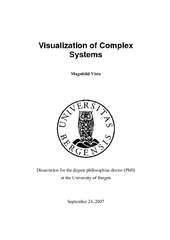| dc.description.abstract | Complex systems are difficult to understand. To aid understanding of complexdynamic systems the field of system dynamics has developed a set of visualizationmethods for graphic representation of the simulation models of complex systems. Theresulting visualizations, however, may sometimes be difficult to understand foraudiences without a background in the scientific investigation of complex dynamicsystems. It is therefore necessary to find new ways of representing complex systemswith the purpose of making them more accessible. This thesis describes how systemdynamic models may be visualized with a particular audience in mind – novicesystem dynamics students. The use of narrative elements and multimedia in thedevelopment of the user interface is explored. A variety of theories and researchfields, such as narrative theory, system dynamics, human computer interaction, andcomputer support for collaboration and learning (CSCL) are utilized in the study. Theproject includes analysis and development of visualizations of system structure,behavior, and narratives that link and explain the relationship between structure andbehavior of complex dynamic systems.Two prototypes of interactive learning environments are developed and evaluated inthe project: The Two-Shower prototype and The Quito prototype. The Two-Showerprototype is based on a small model of a complex system and portrays two showersthat share a hot water tank. The model is a metaphorical model and represents asimple system for resource sharing. The second model is a model of Quito, the capitalof Ecuador, and describes the dynamics of the citizens, tourists, pollution, and themaintenance of Quito’s UNESCO enlisted historic buildings. The Two-Showerprototype is evaluated by usability tests and suggestions for new design are made.The experiences from the development of the Two-Shower prototype are thendiscussed considering how they may be transferred to the Quito prototype, which isbased on a larger model. Being a model of a social system, it portrays issues that aremore complex. Modeling of social systems raises some particular issues regarding choice and representation of variables. The thesis attempts to make bridges betweencomplex system theory, system dynamics, visualization, and learning theory – asrelated to design. | en_US |
